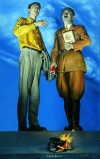Chapter 5: Mao Wherever you Go!
In the year that I was working in the factory, I was granted two months off to paint Mao portraits, because all the factories needed them. The portraits were all in oil, and they were worn out very quickly, so then they had to be painted once more. (Musicologist, 1950s–)
There are many images that simply could not be published. It was very obvious at that time: you could not just “paint Mao” but had to think about the implications all the time. (Intellectual, 1958–)
At the time we really felt that Mao was a god and we were paying reverence to him. (Artist Couple: He 1954–, She 1959–)
If you go interview those who had been Red Guards at the time, you will find that they really believed: Mao was a kind of god for them. They knew it was going to be really hard and difficult, but all went to the countryside, anyway: why did they do so? Because they believed in Mao. (Photographer 1960–)
Mao was one of the most prominent icons of Cultural Revolution China, yet he was not an icon of the Cultural Revolution alone. He remains an important symbol in present-day China, both visually and politically. Like MaoMusic and MaoSpeak, MaoArt was ever-present in China not just during the Cultural Revolution but before and after that period. This chapter will further demonstrate that it was ever-present not just in monotonous repetition but in many variations. Mao did not appear as always the same Mao, and that is true not just before and after the Cultural Revolution but even during this period of alleged “cultural stagnation.” From 1966–71, for example, more than 10,000 different Mao badge designs were in circulation (Schrift 2001).
Although the range of possible variations of his image increased while the overdetermined one and only meaning for these images narrowed both before and after the Cultural Revolution period, evidence shows that even during the Cultural Revolution the actual interpretations of a single image could be quite varied in spite of all semantic limitations prescribed from above (e.g., Chen 1999). Once more, Cultural Revolution interpretative overdetermination, far from creating unified communication, continued to allow for multiple readings in spite of the propagandistic rhetoric accompanying it.
Pre- and post-Cultural Revolution imagery was different, as it almost aggressively provoked and suggested multiple readings. Throughout the history of revolutionary China, the Mao image is contested ground: many suffered and were criticized for the ways in which they depicted the nation’s “Great Leader.” This continues to be true to the present day. It may be just as apt, therefore, to talk of “the danger” rather than “the art” of repetition to describe the perpetuation of MaoArt in revolutionary China (Spengler 1999).
Looking at MaoArt in this study will mean looking at paintings and sculptures from high and low, from the academies and museums to the villages and student newspapers. I will also consider MaoArt in its most popular forms, on posters, badges, cushions, cups, paper money, and talismans, all of which were (and are) widely accessible even in more remote areas. This variety of materials illustrates, once more, that cultural production in revolutionary China was not something exclusively guided and supervised by a monolithic power structure. On the contrary, the production of MaoArt significantly relied on popular agency as well.
Chapter 5 sets out, 1. to uncover significant variation within the repetition of the Cultural Revolution years. It illustrates, 2. how Mao’s Cultural Revolution image came into being as a site of memory and how it developed after the end of that period. Thus, it will help, 3. to uncover the deeper significance of the art of repetition, of redundancy and multiplicity, in Cultural Revolution China and beyond. The chapter probes why and how the Mao image was and still is an important and attractive motif both for the artist who produces and for the viewer who sees such images: Why did and do these people (still) (want to) engage with Mao? To what extent is taking on Mao a performative act—one that signifies everything from self-aggrandizement to self-sacrifice and that reflects as much on the performer as on the image performed? Do personal motives and interpretations contradict or support what the images tell about their implied audience?
It turns out that MaoArt has changed dramatically in nature, but it has changed little in emotional impact. Mao represents running contradictions in Chinese history and politics. Although one cannot take him too personally in a charismatic, religious manner, he was significant and, at times, even omnipotent, but his importance waxed and waned over time, because the contradictions reflected in his image represent the contradictions that Chinese people have collectively undergone and are still trying to resolve. Recontextualizing Mao’s image in myriad ways thus increases its aura and its ever-expanding emotional and intellectual appeal (Schrift 2001, 190).












































































































